Robin LaFevers
Mining Our Characters’ Wounds
While we can certainly be forgiven for not seeing our personal wounds as jewels, our most powerful wounds often have as many facets and hidden depths as an exquisitely cut gemstone. They are sharp, with hard edges that not only reflect back light but distort it somewhat.
As writers, we know that our character’s wounds are some of the most fertile ground for creating a rich, fully realized protagonist. But before we can explore this with our characters, we have to understand it ourselves. And because we have all been wounded in some way—and those places are always tender—it can be uncomfortable to look too closely.
In order to use our characters’ wounds to full effect, we need to understand that wounds aren’t simply an attribute to be filled in on a worksheet. They are the rocket fuel for our character’s backstory, the backstory that drives their motivation and colors their world. It must be deeply organic to that character and so intricately woven into their emotional DNA that it distorts the way the see the world and themselves.
While everyone’s wounds are uniquely theirs, they are also universal in that they’re something we all share. What differs is their nature, how we carry them, and the many—often unexpected—ways they shape us and our behavior.
Because of course the impact of any given wound isn’t limited to that initial injury. I was reminded of that last week when I was out walking and twisted my ankle. It was nothing serious, but by the time I’d limped around favoring it for a day or two, everything else was out of whack as I contorted my body to accommodate the injury.
Emotional wounds are just like that, only worse by orders of magnitude.
Even when we know our character’s painful past, we often don’t use it to full effect. We don’t manage to weave into the very essence of who our character is—because make no mistake, wounds fundamentally shape us, especially those incurred in childhood when we are so defenseless. With wounds of the heart or soul—the ones that violate some deep fundamental part—it is the repercussions of that initial wound that create the most scarring. The blame, the self-doubt, the suffocating shame, all serve as a way to cut us off from our core self.
Emotional neglect, a betrayal, a rejection, a lie, are all painful enough, but often become the lens through which we see ourselves. We accept that rejection. Believe that lie. Justify the betrayal due to something fundamentally flawed within us rather than the betrayer. Or worse, we don’t see it as a betrayal at all, but simple evidence of how flawed and unlovable we really are.
The emotionally abandoned child believes they are undeserving of love.
The abused believes they deserve the abuse, that love will always hurt and often comes coated in shame.
The child of addicts learns to fundamentally mistrust the safety and stability of the world around them.
The child raised in a religion that vilifies all human behavior will inevitably see themselves as sinful and unworthy.
Any kind of abuse—emotional, physical, sexual—is often the starting point for a long, twisted, distorted journey from our true selves. And our worldview takes shape around that bad information we’ve deduced because of it.
One of the biggest challenges we face as writers is how to hook our reader emotionally and forge a connection in those first few pages without becoming the literary equivalent of the stranger in the checking line, blurting out every gory detail of the drama of their lives without even having been asked.
The secret, I think, is to show or hint at the character’s contortions and defense mechanisms that have sprung up around that deeper wound. As readers, we’re trained to look for clues and hints, so we’ll spot those coping mechanisms and be intrigued—we’ll want to know why.
So as writers, we need to ask ourselves: In what ways does our character limp through the world? How do they favor that wounded place inside? What distorted belief do they cling to with both hands? What ways do they disassociate from parts of themselves that brush too closely to that wound? In what ways do they wear their wound like a chip on their shoulder, insisting to the world it has made them tough, impervious to future wounding?
And why are these characters indelibly scarred by these events, when others might brush them off or take them in stride?
I believe the answer to that last question is that because for some, the psychic soil has been well prepared and cultivated—their soil broken down and covered in so much manure before the wound even shows up—that the individual is supremely susceptible to the final blow.
But what about characters who don’t have a tragic or traumatic event in their past? What about lesser, garden variety wounds? The kind we acquire from the simple life lessons of growing older or growing up? Because the majority of the time, these shaping wounds are incurred early in life—either in our childhood, teen, or early adult years.
These less traumatic experiences still shape us, although to what degree will vary widely from character to character and will depend on things like the psychic equivalent of adrenaline, momentum, individual pain thresholds, and how cultivated the soil was.
We all have memories from our childhood, of playing with other kids, either on the playground or in the neighborhood, then taking a fall, skinning our knee or scraping an elbow. Chances are we bounced right up and kept on going, utterly impervious to any pain. At least until it was time to come inside and wash up for dinner. THEN we could feel that sucker throbbing and stinging.
Science has also shown that pain thresholds within the same person vary depending on how stressed our systems are. When we are under chronic stress, our body produces a lot more of some chemicals and fewer of others. The reformulation of our brain chemistry intensifies pain response—both physical and emotional.
So even if the story you’re writing does not involve characters with large traumatic wounds in their past, common everyday wounds can be equally fertile ground for deepening character.
- Why does a character have a gambling problem?
- A shopping addiction?
- Why are they terrified of clowns? Cats? Blimps?
- Why do they feel the need to be perfect?
- So competitive?
Each of those behaviors could be fueled by either a traumatic wound or a common every day one. It is the tone and theme of your story that will decide which it should be. Or rather I should say, it is the nature of your character’s wounds that will determine the tone and theme of your story.
We are often our own worst enemy—there is no denying that. Many writers feel that their character is his own antagonist, and that is likely true. Our desperation to avoid acknowledging our wounds, to avoid awakened that old pain and our deeply held beliefs about the nature of that pain are often an enormous component of getting in the way of our own happiness. It is hard and scary to look that deeply inside and reorient our world view, even it if ultimately frees us. It is scary to be thrust back into the same powerlessness and vulnerability we had in that moment. That is why we need stories to show us how.
Some of our character’s most transformative moments will come from facing those wounds, freeing themselves from the weight of them, and beginning the healing process. And of course, the stories we write aren’t about the wounds—but how we can overcome them.
We need stories to show us that being wounded or broken doesn’t lessen our character’s—or our own—humanity in any way. It is, in fact, what make us deeply human. The best stories show us that having been wounded doesn’t mean we are less than, or broken beyond repair, or unworthy. Instead, they illuminate all the different shapes wounds can take and the many different paths to healing that await us, if only we have the courage to look.
Do you know your character’s defining wounds? Can you brainstorm three to four ways these wounds create behaviors that readers can see on the page?
(Originally published on Writer Unboxed April 13, 2018)
IGNITING DARKNESS–Coming June 2, 2020
Hoping to find an ally from the convent, Sybella instead discovers yet another initiate who has been misled and misused by the former abbess of Saint Mortain. But with long held secrets exposed and allegiances revealed, Sybella must form an uneasy trust borne of desperation to combat enemies at the French court who would have them branded as traitors and heretics.

Some mistakes cannot be fixed—that is Genevieve’s growing fear. Though she may have been a fool, she is no coward and will do whatever it takes to set things right and ensure her Queen’s—and Sybella’s—safety. It will take all of Genevieve’s strength of will and cunning, along with Sybella’s willingness to embrace her growing power. But even that may not be enough.

Plans fail, fragile loyalties are tested, and bridges burn in this riveting conclusion to the Courting Darkness duology. Here, the Daughters of Death finally embrace the full depth of their power—and try to make whole that which has been broken, including themselves.
Want to read more? You’re in luck! My publisher is providing an e-sampler of the first eleven chapters. I hope you have as much fun reading it as I did writing it! (And if you get so excited that you feel like pre-ordering the book–be sure to save your receipts! There will be a pre-order gift. Details coming soon!)
The Charbonnerie and the Dark Mother
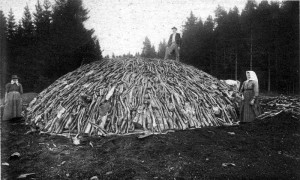 As I wrote Dark Triumph, I wanted to be sure and populate the book with some of the colorful characters from the Middle Ages that I had come across in my research, and yet it had to feel organic to the story and not wedged in there.
As I wrote Dark Triumph, I wanted to be sure and populate the book with some of the colorful characters from the Middle Ages that I had come across in my research, and yet it had to feel organic to the story and not wedged in there.
As Sybella and the wounded knight were racing through the countryside, trying to escape pursuit, I had to do some serious thinking as to who they would actually run in to, and of those people, who would help, who would hinder, and who would turn them in in a heartbeat for a reward. Since they would need to slip into the forest to evade capture, I decided to draw from those who lived in the forests or obtained their livelihood from the woods, and settled upon a group of charcoal burners.
Oddly, it is often the outcasts in society who are most accepting of other outcasts. Their very disenfranchisement sometimes makes them more willing to challenge the status quo or thumb their nose at rigid authority. While charcoal burners were not (probably) true outcasts, they did keep to themselves somewhat, confined by their livelihood to dwelling in forests and tending their charcoal fires rather than living in cities or villages.
In the middle ages, one of the most efficient fuels at the time was charcoal. Coal itself was rare and difficult to mine with their technology, but charcoal could be made through the slow burning of wood, then stopping the process before the wood was fully burned to ash. Charcoal burning was a tricky thing, requiring fairly esoteric knowledge of how to build the fire pits just so, how to pile the wood so it wouldn’t burn too quickly, and how to read the smoke to discern when the charcoal was ready. There were a number of occupational hazards, primarily involving collapsed fire pits and burns. It was also an occupation full of hazard, for a stray spark or ember could start a conflagration in minutes.
As I continued to research charcoal burners, I came across a curious mention of the Carbonnari, a branch of Italian charcoal burners. They started off as a guild, as many medieval trades did, and developed into an organization or brotherhood similar to Freemansons, only with their charcoal burning trade being at the center of their rituals and organizations. While their organization and political involvement was most evident in 19th century Italy, it is believed the groups’ origins began in the middle ages. When I learned they had a French counterpart called the Charbonnerie, I knew I’d found my outcasts.
As a writer, a dozen questions immediately went off in my mind. Who were they? What would compel them to become political and engage themselves in the affairs of the kingdom? How would they make those decisions? And, most importantly in a world populated with patron saints, whom would they worship?
Any deviation from normal church doctrine in the middle ages was rigorously opposed, so it made sense to me that they would worship someone not approved by the church, one of the older gods who’d not make the transition to patron saint.
Dovetailing nicely with this was my personal fascination with the concept of the Black Madonna. There are various theories for the origin of the Black Madonna, whether it was simply the color of Jesus and Mary’s skin before Renaissance artists reimagined them as fair skinned and blonde, or an origin that spoke to possible African roots. There is some speculation that the huge popularity of the cult of the Virgin Mary in the middle ages was a redirecting of earlier earth/mother goddess worship.
But interestingly, over the years I’d also run into mentions of the Black Artemis, rumored to have been worshipped by the Amazons, or Black Demeter, the aspect of the earth goddess when she was in deep mourning for her daughter Persephone. I took all those threads and swirled them around until I had the Dark Matrona, the unsanctioned aspect of Dea Matrona, the former earth goddess now patron saint. I decided that her darkness would be of a more spiritual nature, not unlike the Egyptian god Osiris, for in the Egyptian pantheon, black was not only the color of the underworld, but regeneration as the rich dark silt from the Nile river allowed them to grow their crops each year, and so black was also the color of regeneration, which dovetailed nicely with the book’s themes of finding hope in the darkness.
HFA Refresher: The Mythology of the Nine
While the Nine Old Gods of Brittany are my own invention, they were built on a number of historical, geographical, and ancient theological precedents, so I thought I’d share some of those here for those of you who are curious to know what my inspirations for world of His Fair Assassin were.
As the Catholic Church struggled to gain acceptance among people who were reluctant to let go of their own pagan beliefs, it made a conscious decision to actively subsume those beliefs into Christianity, white washing and Christianizing them along the way. They felt it would make it easier for people to accept the new religion if they could recognize parts of their old beliefs in it.
Brittany was also home to the last remaining group of druidesses, called the Gallinezae, who were said to possess mysterious power. Additionally, Brittany had nine bishoprics, or districts, that were based on the nine earlier Celtic tribes who inhabited the land.
Since Brittany was originally inhabited by the Celtic tribes, I built the mythology of His Fair Assassin on a Celtic foundation. It’s also important to note that I drew from Continental Celtic roots for my mythology rather than the Irish Celts.
Trying to accurately recreate any Celtic beliefs is tricky however, because the Celts themselves did not create any written record of their beliefs or practices; it was all passed along through the oral tradition. In fact, druids in training were required to study for twenty years in order to learn all their lore and history by committing it to memory.
Consequently, nothing of the Celtic religion or spiritual beliefs and practices was written down until they were invaded by Rome. In addition to viewing the Celts practices with scorn, the Romans often interpreted other pantheons according to their own, thus a mother goddess must be equated with Zeus’s wife Hera, or a god of the Underworld with Hades, etc. This Interpretatio romana colored everything we knew about Celtic practices up until fairly recently when improved archaeological techniques and methods began revealing a more complete and accurate picture. The funny thing is though, by the middle ages the myth and folklore of these earlier Celts would have been very much written over and ‘tainted’ by the Romanization of those myths, so that those living in the 15th century would have been more familiar with this Romanized version. Since I set the story in that timeframe, I wanted to be true to that worldview rather than our own, more knowledgeable one.
Here is a list of the Nine Old Gods of Brittany along with their Roman/Greek or Celtic influences/inspiration:
Saint Mortain – god of death. The Celtic equivalent to Dis Pater, the Romanized Celtic god of death, with some similarities to the Welsh Arawn. Greek and Roman counterparts would be Pluto and Hades, but the Celtic Dis Pater had other aspects to him that tied him to older beliefs that enveloped not only the underworld, but the entire cycle of life and death. Also inspired by the Breton figure of personified death, the Ankou.
Dea Matrona – Gaulish mother goddess, responsible for the earth’s bounty. Similar to the Celtic Anu or Ana.
Saint Amourna – daughter of Dea Matrona and one of the twin goddesses of love. Amourna is the gentle aspect of love. The Celtic pantheon had no goddess of love per se, so she definitely has aspects of Aphrodite or Venus. However, the idea of twin sister goddesses representing the dual aspects of love was my own invention.
Saint Arduinna – daughter of Dea Matrona and goddess of love’s sharp bite, protector of virgins. There was a Celtic goddess Arduinna who was a goddess of the forest. Boars, highly revered by the Celts, were sacred to her. Similar to the Gallo-Roman Diana.
Saint Mer – goddess of the sea. While there is no known Celtic god of the sea, there were many deities of springs and lakes, most of whom were goddesses so I decided to make the deity of the sea in my world in keeping with the feminine representations the Celts seemed to favor.
Saint Camulos – god of battle and warriors. Wears a corona of oak leaves and ram’s horns. The Romans equated him with Mars, but I also drew slightly on the cult of Mithros.
Saint Brigantia – goddess of wisdom; brought medicine and healing knowledge to mankind. Based on the Celtic goddess Bridget, who is one of the most widely known pagan goddesses to have become a saint. Her Greek and Roman counterparts would be Athena and Minerva.
Saint Cissonius – god of crossroads and travelers. I took the Celtic Cissonius, god of trade, and expanded on it a bit.
Saint Salonius – god of mistakes and patron saint of bastards. Ah, this is my most historically tenuous god. I have always been a fan of the trickster god who appears in so many pantheons, and I saw a fleeting entry on the Wikipedia Celtic Gods and Goddesses page that reference Salonius, god of mistakes. Alas, when I later went to reference it, the entry was gone and I couldn’t even find it in the Google cache search. Although it seems fitting that my god of mistakes might have been born of one of my own.
HFA Refresher: Anne of Brittany
 Anne of Brittany was a real historic person. At twelve years old, upon the death of her father, she inherited one of the last remaining duchies in Western Europe. By all accounts, she was a remarkable girl. Groomed since birth to inherit the duchy, she was reading and speaking Greek and Latin by the time she was five years old.
Anne of Brittany was a real historic person. At twelve years old, upon the death of her father, she inherited one of the last remaining duchies in Western Europe. By all accounts, she was a remarkable girl. Groomed since birth to inherit the duchy, she was reading and speaking Greek and Latin by the time she was five years old.
Her substantial inheritance was complicated by two things. One, she was a woman at a time when traditionally women did not inherit kingdoms. Since the time of Charlemagne, Salic Law had been invoked to prevent women from becoming rulers. When Anne became Duchess of Brittany, it defied all the conventions of that time. Secondly, and perhaps more importantly, not only was she unmarried, but her father had promised her hand in marriage to at least half a dozen European nobles, if not more. As he plotted and strategized, trying to keep his lands and title safe from the French Crown, he dangled his daughter (and her substantial dowry) as bait for the aid he needed from other princes and dukes. Consequently, when he died, she had been promised to more than one suitor.
To say that this created problems for her in keeping her duchy independent is an understatement. Which is why she needed the help of assassin nuns. What? Doesn’t everybody call for assassin nuns when they’re having political difficulty? If not, they should….
HFA Refresher: Legends of Brittany
In preparation for the publication of COURTING DARKNESS, and because I realize not everyone has time for a re-read of the original trilogy, I thought I would put up some “refresher” posts to help readers reacquaint themselves with the His Fair Assassin world before diving back in. First up: the legends and folklore of Brittany that planted those first seeds in my imagination, lo those many years ago . . .
As I combed through history, looking for the perfect setting for this story, four things caught my attention and eventually solidified into the world of His Fair Assassin. The first was a twelve year old duchess who inherited a kingdom, that inheritance hugely complicated by the fact that she had been promised in marriage to half a dozen princes and nobles.
Next was a mention of the Gallizenae, nine druidesses who lived on the Ile de Sein off the coast of Brittany and possessed mysterious powers.
While Googling for images of the Ile de Sein, I came across of photo of a small, medieval chapel standing next to one of the old, pagan standing stones that are so plentiful in Brittany. It was such a vivid illustration of one of the things that has always fascinated me—how the Catholic Church was so successful at absorbing bits and pieces of the older, ancient religions.
I also learned of a Breton folklore figure call the Ankou, a personification figure of Death.
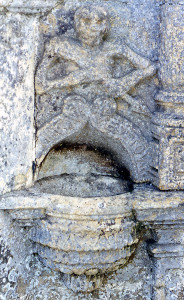
Then lastly, I read about the Passage de l’Enfer—a Breton folktale of fisherman who receive a knock on their door at midnight and were required row the souls of the dead across the ocean at night. Those legends soon became intertwined in my mind and the story idea began to take shape . . .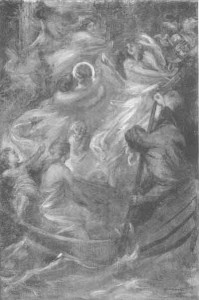
FAQ: Do I Need To Read The HFA Trilogy Before Reading Courting Darkness?
I get asked this a lot, so thought I’d try to address it here.
Courting Darkness is meant to be able to be read without having read the original His Fair Assassin trilogy. But it is not the first book of Sybella’s adventures.
If you read an ARC and were lost—I’m sorry. That is one of the absolute downsides to ARCs—they are unfinished and sometimes relatively unpolished copies. I made THREE more rounds of line edits after the ARCs were printed. A large portion of those changes were to help make Courting Darkness more accessible to new readers and help bring former His Fair Assassin readers up to speed.
I think we succeeded in making it less confusing to new readers. But part of that depends on what sort of reader you are.
Some readers hate to read reviews or synopsis and love trying to piece together the backstory from context clues. Others like every detail spelled out and like a lot of explanation in the narrative. There are definitely readers who hit Courting Darkness cold and thoroughly enjoyed it! Where exactly their reader preferences fell on the above spectrum, I’m not sure.
Part of the problem as a writer was finding a way to revisit the events of Dark Triumph without utterly violating who Sybella is as a character. She is an extraordinarily private person whose past was so difficult that she blocked out most of it for four years. Those early memories will never be something she takes out causally to mull over. To have her do so felt like it cheapened her experience, turning it into something exploitative, even though it would have filled readers in on what had happened in her past. But honestly, I think those experiences of hers will mean more if they are experienced with her rather than recounted in a narrative recap.
So I believe (hope?) you can read Courting Darkness first. With luck, you will enjoy it enough that you’ll want to know more about Sybella and give Dark Triumph a try—it will answer so many questions you might have! But it is very likely that reading Courting Darkness will be a richer experience if you’ve read the trilogy first. But if you haven’t, don’t despair! Sybella’s full backstory will be revisited more fully in the second book in the duology—when events give her no choice but to confront it.


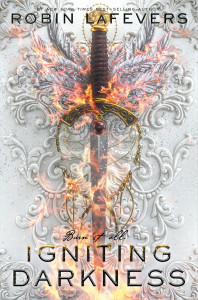
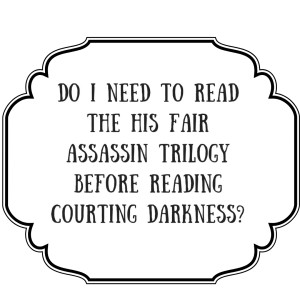
Recent comments